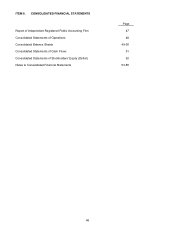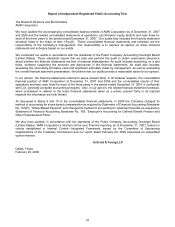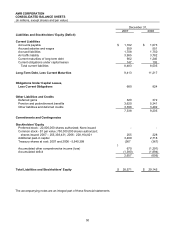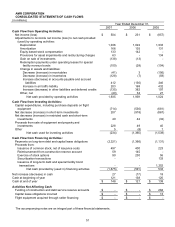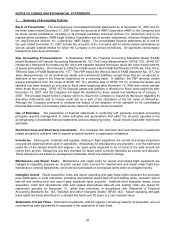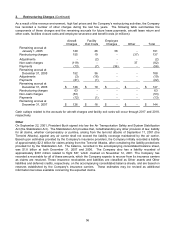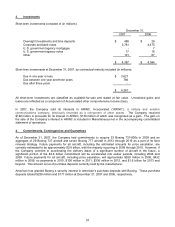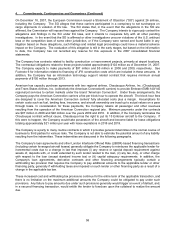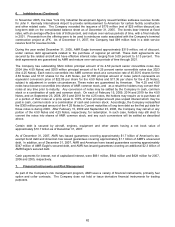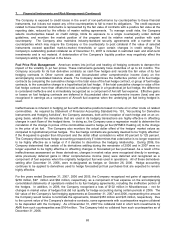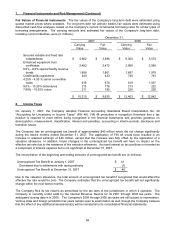American Airlines 2007 Annual Report Download - page 57
Download and view the complete annual report
Please find page 57 of the 2007 American Airlines annual report below. You can navigate through the pages in the report by either clicking on the pages listed below, or by using the keyword search tool below to find specific information within the annual report.
54
1. Summary of Accounting Policies (Continued)
Measurement of Asset Impairments In accordance with Statement of Financial Accounting Standards No.
144, “Accounting for the Impairment or Disposal of Long-Lived Assets” (SFAS 144), the Company records
impairment charges on long-lived assets used in operations when events and circumstances indicate that the
assets may be impaired, the undiscounted cash flows estimated to be generated by those assets are less than
the carrying amount of those assets and the net book value of the assets exceeds their estimated fair value. In
making these determinations, the Company uses certain assumptions, including, but not limited to: (i) estimated
fair value of the assets; and (ii) estimated future cash flows expected to be generated by these assets, which are
based on additional assumptions such as asset utilization, length of service the asset will be used in the
Company’s operations and estimated salvage values.
Equipment and Property The provision for depreciation of operating equipment and property is computed on
the straight-line method applied to each unit of property, except that major rotable parts, avionics and assemblies
are depreciated on a group basis. The depreciable lives used for the principal depreciable asset classifications
are:
Depreciable Life
American jet aircraft and engines 20 - 30 years
Other regional aircraft and engines 16 - 20 years
Major rotable parts, avionics and assemblies Life of equipment to which applicable
Improvements to leased flight equipment Lesser of lease term or expected useful
life
Buildings and improvements (principally on
leased land)
5 - 30 years or term of lease, including
estimated renewal options when
renewal is economically compelled at
key airports
Furniture, fixtures and other equipment 3 - 10 years
Capitalized software 3 - 10 years
Residual values for aircraft, engines, major rotable parts, avionics and assemblies are generally five to ten
percent, except when guaranteed by a third party for a different amount.
Equipment and property under capital leases are amortized over the term of the leases or, in the case of certain
aircraft, over their expected useful lives. Lease terms vary but are generally ten to 25 years for aircraft and seven
to 40 years for other leased equipment and property.
Regional Affiliates Revenue from ticket sales is generally recognized when service is provided. Regional
Affiliates revenues for flights connecting to American flights are based on industry standard proration agreements.
Passenger Revenue Passenger ticket sales are initially recorded as a component of Air traffic liability.
Revenue derived from ticket sales is recognized at the time service is provided. However, due to various factors,
including the complex pricing structure and interline agreements throughout the industry, certain amounts are
recognized in revenue using estimates regarding both the timing of the revenue recognition and the amount of
revenue to be recognized, including breakage. These estimates are generally based upon the evaluation of
historical trends, including the use of regression analysis and other methods to model the outcome of future
events based on the Company’s historical experience, and are recorded at the scheduled time of departure.
Various taxes and fees assessed on the sale of tickets to end customers are collected by the Company as an
agent and remitted to taxing authorities. These taxes and fees have been presented on a net basis in the
accompanying consolidated statement of operations and recorded as a liability until remitted to the appropriate
taxing authority.




